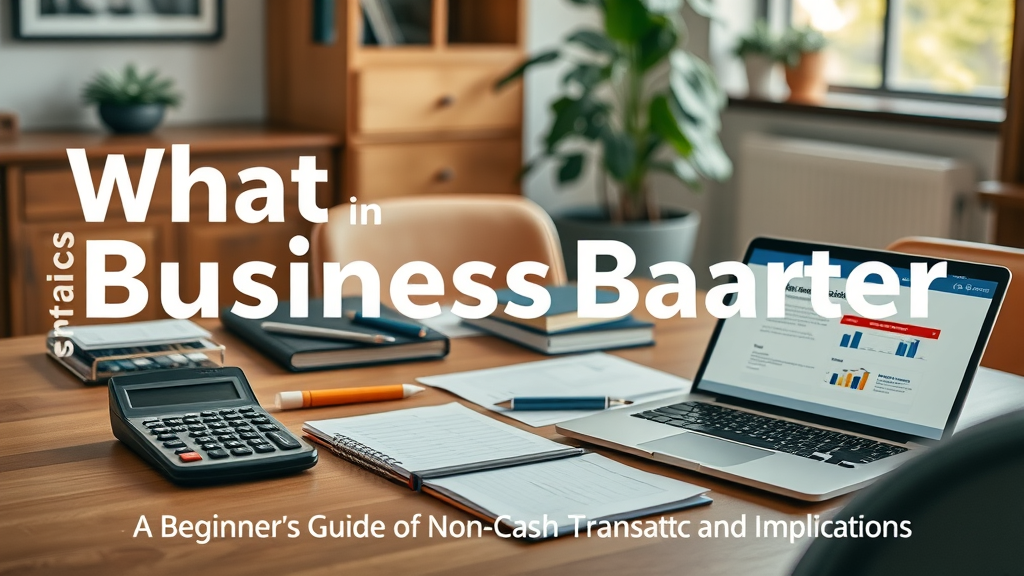In an ever-evolving marketplace, traditional cash transactions are no longer the only way to thrive. Have you ever wondered, “What Is Business Barter?” This beginner’s guide to non-cash transactions is your key to unlocking a treasure trove of opportunities. Imagine exchanging goods and services without spending a dime! By mastering the art of barter, you can conserve cash, access new networks, and foster mutually beneficial relationships. Join us as we delve into the transformative power of business barter and discover how it can revolutionize your transactions today!
Understanding Barter: The Foundation of Non-Cash Transactions
Bartering is the exchange of goods or services without the use of money. This age-old practice allows businesses and individuals to obtain what they need by offering something they have in return. What Is Business Barter? A Beginner’s Guide to Non-Cash Transactions highlights the fundamental principles of bartering and explores its flexibility in various economic conditions.
The History and Evolution of Bartering
Bartering dates back to ancient civilizations, where it was the primary method of trade. People exchanged goods and services directly, relying on the double coincidence of wants, which means that both parties needed to want what the other offered. Over centuries, as economies evolved, so did the methods of bartering, leading to systems that incorporated more complex transactions.
Barter Systems in the Digital Age
Today, technology has transformed bartering through digital platforms. Businesses can now connect with others worldwide, facilitating online barter exchanges. This shift has made it easier than ever to engage in non-cash transactions and has led to the emergence of new barter networks.
The Role of Barter in Economic Growth
Barter can stimulate local economies, especially during economic downturns when cash flow is limited. By allowing businesses to trade goods and services, barter enhances market accessibility and supports sustainability.
| Aspect | Traditional Bartering | Modern Bartering |
|---|---|---|
| Medium of Exchange | Goods/Services | Digital Platforms |
| Transaction Speed | Slower | Instant |
| Geographic Limitations | Local | Global |
- Benefits of Barter:
- Reduces cash flow strain.
- Expands customer base.
- Increases networking opportunities.
“Bartering offers a unique way to access goods and services, especially when cash is tight.” - Expert Insight

Types of Barter Transactions
Bartering can take various forms, each serving different purposes. Understanding these types can help you navigate the barter landscape effectively.
Direct Exchange vs. Indirect Exchange
- Direct Exchange: This is a straightforward transaction where two parties trade goods or services directly.
- Indirect Exchange: Involves a third party, often using a barter currency or trade dollar, making it easier to find a match for the desired goods or services.
Local Barter Networks
Local barter networks connect businesses within a community, allowing participants to trade goods and services without the need for cash. These networks often require a membership fee but provide an excellent opportunity for local businesses to thrive.
Online Barter Platforms
With the rise of technology, many online platforms facilitate bartering. These platforms allow users to list what they offer and what they need, making transactions seamless and efficient.
| Network Type | Characteristics | Examples |
|---|---|---|
| Local Barter Network | Community-focused | Local exchange groups |
| Online Barter Platform | Global reach | BarterQuest, Swap.com |
- Pros of Online Bartering:
- Access to a wider audience.
- Increased transaction speed.
- Ability to find specific goods or services.
“Joining a local barter network can open doors to new opportunities and partnerships.” - Business Strategist

The Benefits of Bartering
Bartering has numerous advantages for businesses looking to conserve cash and build relationships.
Cost Savings: Save Money through Barter
Bartering enables businesses to obtain goods and services without spending cash, allowing them to allocate funds elsewhere. This can be particularly beneficial for small businesses with limited budgets.
Creating Fair Trade Opportunities
Bartering promotes fair trade by allowing businesses to value their own goods and services while receiving equal value in return. This fosters ethical business practices and sustainable economic growth.
Developing Local Business Relationships
Engaging in barter helps establish strong relationships with local businesses. These connections can lead to future collaborations and partnerships, enhancing overall community resilience.
| Benefit | Description |
|---|---|
| Cost Efficiency | Reduces cash expenditures. |
| Ethical Trade | Promotes fair value exchanges. |
| Community Ties | Strengthens local business networks. |
- Key Benefits of Bartering:
- Enhances sustainability.
- Encourages creativity in business practices.
- Improves cash flow.

Barter Transactions and Tax Implications
Understanding the tax implications of barter transactions is crucial for businesses to avoid legal troubles.
Understanding Taxable Income from Barter Transactions
According to the IRS, bartering is considered income and must be reported on tax returns. Businesses should keep detailed records of their barter transactions for accurate tax reporting.
Legal Aspects of Bartering
Bartering is legal in most jurisdictions, but businesses must ensure compliance with local laws and regulations. Contracts can help clarify the terms of the exchange, protecting both parties involved.
Filing Forms for Bartered Goods and Services
When reporting barter income, businesses must use specific forms. The IRS requires businesses to report the fair market value of goods or services received through barter.
| Tax Requirement | Description |
|---|---|
| Taxable Income | Bartered goods and services are taxable. |
| Record Keeping | Maintain logs of transactions for tax purposes. |
| Reporting Forms | Use IRS forms to report barter income. |
- Important Tax Considerations:
- Keep accurate records of transactions.
- Consult with a tax professional for guidance.
- Be aware of local laws regarding bartering.

How to Get Started with Bartering
Embarking on a bartering journey can be straightforward if you follow the right steps.
Joining a Barter Network
Start by researching local and online barter networks that align with your business goals. These networks can provide a solid foundation for successful bartering.
Creating a Barter Business Plan
Developing a barter business plan helps outline what you can offer and what you need in return. This plan should include goals, potential partners, and strategies for negotiation.
Engaging in Successful Bartering Activities
Once your plan is in place, actively engage in bartering by attending local events, connecting with other businesses, and utilizing online platforms.
| Step | Description |
|---|---|
| Research | Identify suitable barter networks. |
| Planning | Develop a clear barter business plan. |
| Networking | Connect with potential barter partners. |
- Getting Started with Barter:
- Identify your barterable goods/services.
- Set clear goals for your bartering activities.
- Be open to negotiation and creative solutions.

Successful Bartering Strategies
To maximize the benefits of bartering, consider implementing effective strategies.
Establishing Clear Expectations
Before entering a barter agreement, ensure both parties understand the terms clearly. This reduces the risk of misunderstandings and enhances transactional success.
Dispute Resolution in Barter Transactions
Having a plan for resolving disputes can help maintain positive relationships. This could involve mediation or establishing guidelines for conflict resolution.
Utilizing Bartering as a Business Strategy
Incorporate bartering into your overall business strategy. This can include regular assessments of what goods or services you can offer and how they align with your business goals.
| Strategy | Description |
|---|---|
| Clear Communication | Establish open lines of communication. |
| Dispute Management | Develop a clear dispute resolution process. |
| Strategic Planning | Integrate bartering into your business model. |
- Tips for Successful Bartering:
- Keep communication open and transparent.
- Document agreements and terms clearly.
- Build trust with your trading partners.

Resources and Tools for Bartering
To enhance your bartering experience, utilize various resources and tools available.
Online Platforms for Effective Bartering
There are numerous online platforms designed to facilitate barter transactions. These platforms help users list their offers, making it easier to find suitable trading partners.
Tools to Create Business Plans for Bartering
Utilize business planning tools to outline your barter strategy. These tools can streamline the planning process and ensure you’re well-prepared for negotiations.
Bartering Resources and Communities
Joining bartering communities can provide valuable insights and support. Engaging with others in the barter network can lead to new opportunities and partnerships.
| Resource Type | Description |
|---|---|
| Online Platforms | Websites that facilitate barter transactions. |
| Planning Tools | Software to assist in business plan creation. |
| Community Support | Networks that provide resources and networking. |
- Essential Bartering Resources:
- Explore online barter platforms.
- Leverage planning tools for clarity.
- Engage with bartering communities for support.

Key Takeaways on Business Barter
Understanding the fundamental aspects of bartering can transform your business practices. Here are the key takeaways:
- What Is Business Barter? A Beginner’s Guide to Non-Cash Transactions emphasizes the importance of non-cash transactions in today’s economy.
- Bartering has a rich history and has evolved significantly with the advent of technology.
- Various types of bartering exist, including direct and indirect exchanges.
- The benefits of bartering include cost savings, ethical trade opportunities, and strengthened local relationships.
- Tax implications must be considered carefully to ensure compliance with regulations.
- Getting started involves joining networks, creating plans, and engaging actively in transactions.
- Successful bartering relies on clear expectations and effective communication.

Further Learning: Recommended Videos and Readings
To deepen your understanding of bartering, explore the following resources:
Influential Business Books on Bartering
- “The Art of Barter” - A comprehensive guide on bartering strategies.
- “Barter: The Ultimate Guide” - Insights into effective bartering practices.
Videos that Enhance Understanding of Bartering Practices
- What Is Bartering? - A video explaining the fundamentals of bartering.

Conclusion
Bartering represents a powerful alternative to traditional cash transactions. By understanding the principles of bartering and how to implement them in your business, you can unlock numerous opportunities while conserving cash. Whether through local networks or online platforms, mastering What Is Business Barter? A Beginner’s Guide to Non-Cash Transactions will empower you to navigate your business landscape more effectively.
- Key Points to Remember:
- Bartering can save money and create fair trade opportunities.
- Understanding tax implications is crucial for compliance.
- Engaging actively in barter networks can yield significant benefits.
- Establishing clear expectations and communication is vital for successful transactions.
By incorporating bartering into your business strategy, you can foster mutually beneficial relationships and thrive in an ever-changing economic environment.
Feel free to explore further and start your bartering journey today!
 Add Row
Add Row  Add
Add 

Write A Comment